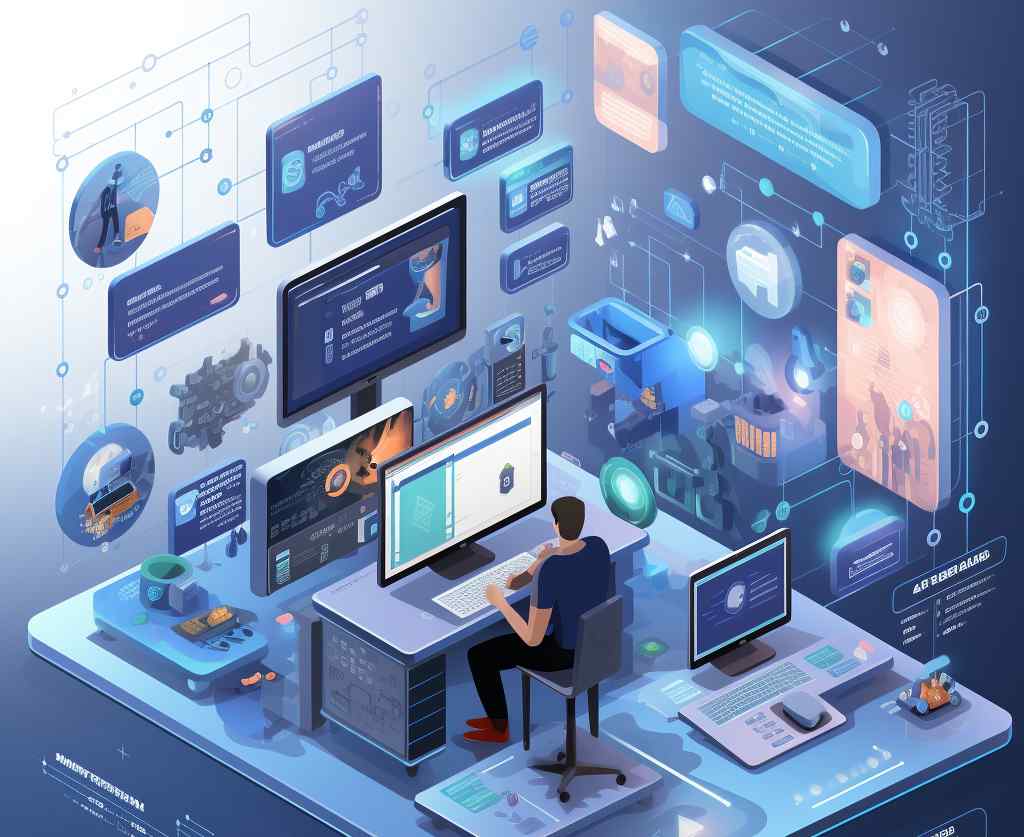
1. Introduction
1.1. Understanding Software as a Service (SaaS)
Software as a Service, often shortened to SaaS, is a software delivery model where applications are hosted by a service provider and made available to users over the internet. SaaS is part of the larger cloud computing sector, alongside Infrastructure as a Service (IaaS) and Platform as a Service (PaaS).
With SaaS, you don’t need to install and run applications on your personal computer or in your data center. Instead, you access the software via the internet, usually on a subscription basis. This model eliminates the need for hardware acquisition, provisioning and maintenance, as well as software licensing, installation, and support. Examples of SaaS include Google Apps, Dropbox, Salesforce, and Microsoft 365.
1.2. The Evolution of SaaS
The SaaS model has its roots in the centralized computing infrastructure of the 1960s. However, it wasn’t until the internet became ubiquitous in the late 1990s and early 2000s that SaaS began to mature into its current form.
The late 1990s and early 2000s saw the rise of Application Service Providers (ASPs) who offered businesses the option to host and manage their software applications remotely. The ASP model became an early form of what we now recognize as SaaS. Salesforce, launched in 1999, is often recognized as the first successful B2B SaaS company and set the model for many SaaS businesses to come.
The evolution of SaaS was further catalyzed by advancements in browser technology, broadband connectivity, and the maturing of Service-Oriented Architecture (SOA), which made web-delivered software more useful and powerful.
The past decade has seen the SaaS model gaining immense popularity due to its scalability, efficiency, and reduced total cost of ownership for software applications. Today, the SaaS industry has expanded into virtually every software category, including email, collaboration, customer relationship management (CRM), billing, HR management, and more.
1.3. Advantages of SaaS
- Lower Costs: SaaS can significantly lower costs as it eliminates the need for installing and maintaining software. Users also avoid the hefty costs associated with hardware acquisition, maintenance, and IT staffing.
- Accessibility: SaaS applications can be accessed from any internet-enabled device, allowing for remote work and collaboration among team members spread across different locations.
- Scalability and Flexibility: SaaS providers generally offer various subscription plans, enabling customers to scale usage up or down based on their needs. This elasticity is a significant advantage over traditional software sales models.
- Automatic Updates: SaaS providers take care of updates and patches, ensuring users always have the latest version of the software without needing to worry about the update process.
- Ease of Implementation: As the software is already installed and configured in the cloud, deployment time for SaaS solutions is significantly reduced compared to traditional software deployment.
1.4. Disadvantages of SaaS
- Dependence on Internet Connectivity: Since SaaS applications are delivered over the internet, users need to be connected to the internet to use them. Any connectivity issues can disrupt access to the software.
- Data Security: While many SaaS providers offer robust security measures, hosting sensitive data on the cloud could pose potential security risks. It’s crucial to ensure that the SaaS provider has stringent security protocols in place.
- Limited Customization: Some SaaS applications may not allow for the same level of customization as traditional on-premise software. Users are typically dependent on the provider to add specific features or enhancements.
- Potential Over Time Costs: While SaaS has a lower upfront cost, the subscription model could potentially lead to higher costs over time as compared to a one-time purchase software.
1.5. Potential Earnings and Market Size in the SaaS Industry
The SaaS industry has seen exponential growth in the past few years, and this trend is expected to continue. According to a report by Gartner, the global SaaS market size was worth around $104.7 billion in 2020 and is expected to reach $140.6 billion by 2022. Other forecasts suggest that the market could be worth as much as $220 billion by 2022. This growth is driven by the increasing adoption of cloud-based services across all industries.
The earnings potential for SaaS companies is significant. Due to the subscription-based revenue model, SaaS businesses can generate consistent, recurring revenue, which is highly valued by investors and stakeholders. This consistent revenue stream can lead to high valuations for SaaS companies. For example, Salesforce, a leading SaaS company, reported $21.25 billion in revenue for its 2021 fiscal year.
However, the potential earnings for a SaaS business can vary significantly based on factors such as the size of the target market, pricing strategy, customer acquisition and retention rates, and operational costs. It’s also important to note that while the SaaS model can be highly profitable, it also requires substantial upfront investment in product development and customer acquisition.

2. Getting Started
2.1. Identifying a SaaS Idea
Starting a SaaS business begins with identifying a viable idea. Here are some steps to help you come up with a SaaS idea:
- Identify a Problem: Look for common problems within your industry, in your daily life, or problems reported by others. A great SaaS idea often comes from a pressing problem that needs a solution.
- Market Research: Conduct extensive market research to understand what solutions currently exist and where the gaps are. Look at online reviews, customer feedback, and industry trends.
- Consider Your Skills and Interests: It’s beneficial if your SaaS idea aligns with your skills and interests. This alignment can provide a competitive edge and make the journey more enjoyable.
- Validate Your Idea: Once you have an idea, validate it. You can do this by talking to potential customers, conducting surveys, or even launching a pre-sales campaign.
2.2. Building a Minimum Viable Product (MVP)
After identifying and validating your idea, the next step is to build a Minimum Viable Product (MVP). An MVP is a product with enough features to attract early-adopter customers and validate the product idea early in the product development cycle.
- Define the Core Features: Identify the key features that will solve the problem you’ve identified. Prioritize these features for your MVP.
- Develop the MVP: With the core features defined, develop the MVP. You may need to hire a development team or outsource this task if you lack the necessary skills.
- Test and Gather Feedback: Launch your MVP to a select group of early users. Gather feedback to understand what works, what doesn’t, and what additional features or improvements are needed.
- Iterate: Use the feedback to make improvements to your product. This is a continual process of testing, gathering feedback, and making improvements based on that feedback.
2.3. Best Practices in SaaS Development
- Focus on User Experience: Ensure the software is intuitive and easy to use. Prioritize user experience (UX) from the design phase itself.
- Security: Implement robust security measures to protect user data. This includes encryption, secure user authentication, regular security audits, and adherence to various compliance standards.
- Scalability: Design the application to handle growth in user base, data volume, and transaction volume. SaaS applications should be designed to scale easily with increased demand.
- APIs and Integration: Provide APIs and integration capabilities with other popular platforms. Customers often prefer SaaS solutions that can integrate well with their existing software ecosystem.
- Continuous Delivery: Adopt continuous delivery practices to release updates and improvements quickly and frequently.
2.4. Things to Consider When Launching a SaaS
- Market Fit: Ensure your product addresses the needs of your target market. Initial feedback from your MVP testing should provide insights into this.
- Pricing Strategy: Decide on a pricing model that works best for your product, market, and customer base. This could be a flat-rate subscription, usage-based, tiered pricing, or a freemium model.
- Customer Support: Be prepared to offer excellent customer support from day one. This includes a comprehensive knowledge base, support via email or chat, and quick response times.
- Marketing and Sales Strategy: Have a solid plan for how you will attract and convert prospects. This could include content marketing, SEO, social media marketing, email marketing, and more.
- Legal Aspects: Ensure you have all the necessary legal considerations in place, including terms of service, privacy policy, data protection practices, and intellectual property protection.
2.5. SaaS Improvement Strategies
- Listen to Your Customers: Regularly ask for feedback from your users and act on it. Customers can provide valuable insights into what features need improvement or what new features need to be added.
- Monitor Key Performance Indicators (KPIs): Track metrics like churn rate, customer acquisition cost, customer lifetime value, and monthly recurring revenue to measure the health of your SaaS business. These metrics can guide your improvement strategies.
- A/B Testing: Regularly conduct A/B tests to optimize every aspect of your SaaS product, including its features, user interface, pricing, and marketing tactics.
- Regular Updates and Upgrades: Continually update and upgrade your product to meet changing market demands and to stay ahead of competitors.
- Invest in Customer Success: Ensure your customers are achieving their desired outcomes using your product. This can improve customer satisfaction, reduce churn, and increase upselling and cross-selling opportunities.
2.6. Maintenance Tips for SaaS Platforms
- Ensure High Availability: Minimize downtime by using reliable hosting services, implementing redundancy and failover mechanisms, and regularly backing up data.
- Monitor Performance: Use application performance monitoring tools to detect and resolve performance issues before they affect your users.
- Routine Security Checks: Regularly test and update your security measures to protect against new threats and vulnerabilities.
- Update and Patch Management: Regularly update and patch your software to fix bugs, add new features, and improve security.
- Data Management: Regularly clean and update your databases to maintain optimal performance and ensure data accuracy.

3. Growth
3.1. Customer Acquisition Strategies
- Content Marketing: Produce high-quality, relevant content to attract and engage your target audience. This includes blog posts, white papers, webinars, tutorials, and case studies.
- Search Engine Optimization (SEO): Optimize your website and content for search engines to increase visibility and organic traffic.
- Paid Advertising: Use paid advertising channels like Google Ads, social media ads, and display ads to attract potential customers.
- Social Media Marketing: Leverage social media platforms to engage with your audience, share content, and promote your product.
- Email Marketing: Use email marketing to nurture leads, share updates and content, and convert prospects into customers.
- Partnerships and Integrations: Partner with other businesses or platforms to reach a wider audience and provide more value to your users.
3.2. Retention and Churn Management
- Provide Excellent Customer Service: Prompt and helpful customer service can significantly improve customer satisfaction and retention.
- Customer Success: Invest in customer success initiatives to help your customers achieve their goals using your product. This includes onboarding assistance, educational resources, and regular check-ins.
- Product Improvement: Continuously improve your product based on customer feedback and changing market needs.
- Subscription Management: Make it easy for customers to manage their subscription, including upgrades, downgrades, and cancellations.
- Regular Communication: Maintain regular communication with your customers through newsletters, product updates, and personalized messages.
3.3. Scaling Infrastructure
One of the challenges faced by growing SaaS businesses is scaling their infrastructure to handle increased load and traffic. Here are some strategies to effectively scale your SaaS infrastructure:
- Elastic Infrastructure: Use cloud-based services that can automatically scale based on demand. Services like AWS, Google Cloud, and Microsoft Azure offer auto-scaling features where resources can be increased or decreased based on the load.
- Microservices Architecture: Consider using a microservices architecture, where your application is divided into small, loosely coupled services. Each service can be scaled independently, improving efficiency and reducing costs.
- Load Balancing: Implement load balancing techniques to distribute traffic evenly across your servers, preventing any one server from becoming a bottleneck.
- Database Scaling: Use database technologies that can handle increased read and write loads. This might involve techniques like sharding, replication, or using a NoSQL database.
- Caching: Implement caching strategies to reduce the load on your databases and improve response times. This could involve using a Content Delivery Network (CDN) or in-memory caching systems like Redis or Memcached.
- Performance Monitoring: Use application performance monitoring (APM) tools to identify performance bottlenecks and areas that need scaling.
Remember, scaling is not just about handling increased load, but also maintaining or improving performance and user experience as your user base grows.
3.4. Expanding to New Markets
As your SaaS business grows, you may consider expanding into new markets. Here’s a step-by-step guide:
- Market Research: Identify potential new markets by analyzing factors like customer needs, market size, competition, and regulatory environment.
- Localization: Adapt your product to meet the needs and preferences of the new market. This may involve translating content, adjusting pricing, or modifying features.
- Partnerships: Partner with local businesses or influencers to gain credibility and access to their network.
- Marketing and Sales Strategy: Develop a marketing and sales strategy tailored to the new market. This might involve different channels or messaging than your existing markets.
- Customer Support: Provide customer support in the local language and time zone, and adjust your support methods if necessary.
- Legal and Regulatory Compliance: Ensure your product and business practices comply with local laws and regulations.
3.5. Future Trends in SaaS and How to Leverage Them
- AI and Machine Learning: AI and ML are increasingly being used in SaaS products for predictive analytics, personalization, automation, and more. Leverage these technologies to improve your product and provide more value to your customers.
- Micro-SaaS: Micro-SaaS is a trend where small teams build highly focused SaaS products that serve a niche market. This could be an opportunity for small businesses or solo entrepreneurs to enter the SaaS market.
- Vertical SaaS: This involves creating SaaS products tailored for specific industries or professions. As markets become more saturated, vertical SaaS can be a way to differentiate and target high-value niches.
- API-first SaaS: As businesses use more and more software, the need for these applications to integrate and communicate increases. API-first SaaS products are built to integrate easily with other platforms, providing more value to users.
- Data Privacy: With growing concerns about data privacy, SaaS companies will need to prioritize transparency and compliance with data privacy regulations.

4. Marketing
4.1. Understanding Your Target Audience
Understanding your target audience is critical for effective marketing. Here are steps to help you understand your audience:
- Identify Your Ideal Customer: Determine who benefits most from your product. Consider factors like industry, company size, job role, and common pain points your product addresses.
- Conduct Market Research: Use surveys, interviews, and data analysis to learn about your target customers’ preferences, behaviors, and needs.
- Create Customer Personas: Develop detailed profiles of your ideal customers, including their demographics, interests, challenges, and buying behavior.
- Analyze Your Competitors: Understand who your competitors are targeting and how they position their product. This can help you identify gaps and opportunities in the market.
- Test and Refine: Continuously test your assumptions about your target audience and refine your understanding based on feedback and data.
4.2. Content Marketing for SaaS
Content marketing is an effective way to attract and engage your target audience. Here are some strategies:
- Blog Posts: Regularly publish informative and engaging blog posts that answer common questions, provide insights, or discuss industry trends.
- White Papers and E-books: Create in-depth guides or reports that provide value to your audience. These can also be used as lead magnets to collect contact information.
- Webinars and Videos: Host webinars or create videos that demonstrate your product, share expert knowledge, or discuss relevant topics.
- Case Studies: Share success stories of customers who have benefited from your product. This provides social proof and helps potential customers understand how they can benefit from your product.
- Email Newsletters: Send regular newsletters to share your content, provide updates, and stay top of mind with your audience.
- SEO: Optimize all content for relevant keywords to increase visibility in search engines.
4.3. Social Media Strategies
Social media is a powerful tool for SaaS companies to connect with their audience, increase visibility, and generate leads. Here are some strategies:
- Choose the Right Platforms: Not all social media platforms may be suitable for your business. Choose platforms where your target audience is most active.
- Consistent Branding: Ensure consistent branding across all social platforms to create a cohesive brand identity.
- Engaging Content: Post content that resonates with your audience, such as industry news, product updates, user-generated content, and behind-the-scenes looks at your company.
- Customer Interaction: Engage with your audience by responding to comments, answering queries, and actively participating in discussions.
- Social Listening: Monitor social media for mentions of your brand, competitors, or industry keywords to understand the conversation around your business.
- Paid Advertising: Consider using social media ads to reach a broader audience and generate leads.
4.4. Email Marketing in SaaS
Email marketing can be a highly effective tool for SaaS companies for lead nurturing, customer engagement, and retention. Here are some tips:
- Segment Your Audience: Segment your email list based on factors like customer lifecycle stage, usage behavior, or industry to send more relevant emails.
- Personalization: Personalize your emails based on the recipient’s behavior, preferences, or needs to increase engagement.
- Automated Campaigns: Use automated email campaigns for user onboarding, feature adoption, or re-engagement. These can be triggered based on user behavior.
- Regular Updates: Send regular newsletters or updates to keep your audience engaged and informed about your product.
- Track and Optimize: Monitor key metrics like open rates, click-through rates, and conversion rates to understand the effectiveness of your emails and continuously optimize your strategy.
4.5. SEO for SaaS Companies
Search engine optimization (SEO) is essential for SaaS companies to improve their visibility in search engine results and attract organic traffic. Here are some SEO strategies for SaaS:
- Keyword Research: Identify keywords that your target audience uses to search for solutions like yours. Use these keywords strategically in your website content, meta tags, URLs, and alt text.
- On-Page SEO: Optimize your website pages with relevant keywords, meta descriptions, title tags, and header tags. Ensure your website is mobile-friendly and loads quickly.
- Content Creation: Create valuable, keyword-optimized content that answers your audience’s questions and showcases your expertise. This could be blog posts, whitepapers, case studies, or webinars.
- Link Building: Build high-quality backlinks to your website by guest posting, collaborating with influencers, or creating shareable content. Backlinks increase your site’s authority and improve its ranking in search engine results.
- Technical SEO: Ensure your website is easily crawlable and indexable by search engines. This involves a clean site structure, a sitemap, and effective use of robots.txt.
- Local SEO: If your SaaS company serves a local market, optimize your site for local search by claiming your business listing on Google My Business and other directories.
- Tracking and Analysis: Use SEO tools like Google Analytics and Search Console to track your performance, understand your audience’s behavior, and identify areas for improvement.
Remember, SEO is a long-term strategy, and it takes time to see results. Consistently monitoring and tweaking your strategy based on performance is key to success.

5. Legal
5.1. Licensing and Intellectual Property Considerations
Running a SaaS business involves several licensing and intellectual property considerations.
- Software Licensing: As a SaaS provider, you grant customers a license to use your software, typically through a subscription model. The terms of this license are typically laid out in a software license agreement or terms of service.
- Intellectual Property Protection: You’ll need to protect your software’s intellectual property rights, which might involve registering trademarks for your brand, applying for patents if your software includes unique functionality, and maintaining trade secrets around proprietary algorithms or processes.
- Open Source Software: If you use open source software in your product, ensure you comply with the license terms of that software. Some open source licenses have strict conditions that can impact your ability to commercialize your product.
5.2. Data Privacy and GDPR Compliance
Data privacy is a critical consideration for SaaS businesses, especially if you collect or process personal data.
- Data Protection Laws: You must comply with data protection laws in the regions where your customers are based. This might include the General Data Protection Regulation (GDPR) in the EU, the California Consumer Privacy Act (CCPA) in the U.S., and similar laws in other regions.
- Privacy Policies: Your privacy policy should clearly explain what data you collect, how you use it, and how users can control their data. This policy should be easily accessible to your users.
- Data Processing Agreements: If you use third-party vendors to process personal data, you’ll need a data processing agreement that ensures they comply with data protection laws.
- Data Security: Implement robust security measures to protect personal data, including encryption, access controls, and regular security audits.
5.3. Terms of Service and User Agreements
Terms of Service (ToS), also known as Terms and Conditions (T&C), and User Agreements are legal agreements between a SaaS company and its users that outline the rules for using the software. They play a crucial role in protecting your business legally and setting clear expectations for users. Here are some key considerations when drafting these agreements:
- Usage Terms: Define how customers can and cannot use your software. This may include restrictions on illegal use, reverse-engineering, or sharing account access.
- Payment Terms: Clearly outline your pricing, payment terms, and refund policy. If you offer a subscription service, explain how renewals and cancellations work.
- Intellectual Property: Make it clear that your company retains all intellectual property rights for the software.
- Liability Limitations: Limit your company’s liability in case of service interruptions, data loss, or other issues.
- Privacy Policy: Include or reference your privacy policy explaining how you handle user data.
- Termination Clause: State the conditions under which you may terminate a user’s access to your service.
- Dispute Resolution: Specify how disputes will be handled, whether through arbitration, mediation, or court proceedings, and in which jurisdiction.
- Updates and Changes: Reserve the right to update the terms and require users to agree to the updated terms to continue using your service.
Remember, these agreements are legally binding, so it’s crucial to work with a lawyer to draft and review them. They should be easily accessible to users, typically through a link on your website or within your app.
5.4. Regulatory Considerations in SaaS
SaaS companies must comply with various regulations depending on their industry and the nature of their services. For example:
- Data Protection and Privacy: Laws like the GDPR and CCPA govern how companies handle personal data.
- Financial Services: SaaS companies providing services in the financial industry may need to comply with regulations such as the Sarbanes-Oxley Act (SOX) in the U.S. or the Payment Services Directive (PSD2) in the EU.
- Healthcare: If your SaaS product deals with health information, you need to comply with the Health Insurance Portability and Accountability Act (HIPAA) in the U.S.
- Education: If your SaaS product is used by schools or involves student data, you may need to comply with the Family Educational Rights and Privacy Act (FERPA) in the U.S.
5.5. Legal Issues in International Expansion
When expanding your SaaS business internationally, you’ll need to consider several legal issues:
- Local Laws: You’ll need to understand and comply with the local laws of each country you operate in. This may involve changes to your terms of service, privacy policy, or business practices.
- Data Localization: Some countries require that certain types of data be stored within their borders. You’ll need to understand these requirements and set up appropriate data storage and processing arrangements.
- Tax Compliance: You’ll need to understand and comply with the tax laws in each country you operate in. This might include value-added tax (VAT) on sales in the EU or Goods and Services Tax (GST) in countries like Australia and India.
- Currency and Payment Regulations: Some countries have regulations about currency exchange, repatriation of profits, and acceptable payment methods.
It’s crucial to consult with legal and financial advisors familiar with the specific regulations of the countries you’re expanding to.

6. Detailed Insights
6.1. Understanding SaaS Metrics
Understanding and tracking key SaaS metrics is crucial for evaluating your business’s health and making informed decisions. Here are some important SaaS metrics:
- Monthly Recurring Revenue (MRR): This is the predictable revenue your company earns each month from subscriptions.
- Annual Recurring Revenue (ARR): This is the annual version of MRR, particularly useful for businesses with annual subscriptions.
- Customer Acquisition Cost (CAC): This is the average cost of acquiring a new customer, including marketing and sales expenses.
- Lifetime Value (LTV): This is the total revenue you can expect from a customer over their lifetime.
- Churn Rate: This is the percentage of customers who cancel their subscription within a given time period.
- Net Promoter Score (NPS): This measures customer satisfaction and loyalty by asking customers how likely they are to recommend your product to others.
6.2. Pricing Models in SaaS
Choosing the right pricing model is crucial for your SaaS business’s profitability and growth. Here are some common SaaS pricing models:
- Per User Pricing: This is a common model where customers pay per user account. While it’s easy to understand, it may discourage customers from adding more users.
- Tiered Pricing: In this model, different tiers offer varying levels of service or features at different prices. This allows customers to choose a plan that fits their needs and budget.
- Usage-Based Pricing: Here, customers pay based on their usage of the service. This can be ideal for products where usage varies significantly between customers.
- Flat-Rate Pricing: This model offers unlimited access to the software for a single price. It’s straightforward, but may not maximize revenue if users have different needs and usage levels.
- Freemium: This model offers basic services for free, with additional features or capacity available for a fee. It can drive user adoption, but requires a careful balance to encourage upgrades to paid plans.
Each model has its pros and cons, and the best choice depends on factors like your target market, product complexity, and cost structure.
6.3. Security Best Practices
Security is a critical aspect of any SaaS business, as it directly impacts the trust and confidence of your customers. Here are some best practices to ensure the security of your SaaS platform:
- Data Encryption: Encrypt data both at rest and in transit. Use protocols like HTTPS and TLS for data in transit and AES for data at rest.
- Secure Development Practices: Implement a secure development lifecycle that includes security training for developers, threat modeling, and regular security audits.
- Authentication and Authorization: Implement strong authentication mechanisms like two-factor authentication (2FA) and use role-based access control (RBAC) to ensure users only have access to data and functions they need.
- Regular Updates and Patching: Regularly update and patch your systems to fix known vulnerabilities.
- Backup and Disaster Recovery: Regularly backup data and implement a disaster recovery plan to minimize data loss and downtime in case of a disaster.
- Intrusion Detection and Prevention Systems (IDPS): Use IDPS to detect and prevent potential threats in real-time.
- Privacy Compliance: Ensure your practices are in line with data privacy regulations such as GDPR or CCPA.
- Security Certifications: Achieve and maintain security certifications like ISO 27001 or SOC 2 to demonstrate your commitment to security to your customers and partners.
Remember, security is not a one-time task but an ongoing process of constant vigilance and improvement.
6.4. SaaS User Experience Design
Good user experience (UX) design can significantly impact your SaaS product’s success. Here are some key principles:
- Simplicity: Keep the interface clean and intuitive. Avoid cluttering with too many elements. The user should understand how to use your product with minimal guidance.
- Consistency: Maintain consistency throughout your product in terms of color schemes, fonts, and design elements. This creates a seamless experience for users.
- Responsiveness: Your product should be responsive, i.e., it should work well on different devices and screen sizes.
- Feedback & Interaction: Provide clear feedback to user actions. For instance, if a user clicks a button, there should be a clear indication that something is happening.
- User Onboarding: Create an effective onboarding process to guide new users through your product. This could include tutorials, tool tips, or walkthroughs.
- User Testing: Regularly conduct user testing to understand pain points and areas for improvement.
6.5. SaaS Customer Support and Service
Customer support and service are crucial to SaaS businesses, as they directly impact customer satisfaction and retention. Here are some best practices:
- Multi-Channel Support: Offer support through multiple channels like email, chat, phone, and social media. This allows customers to reach out via their preferred method.
- Knowledge Base: Maintain a comprehensive, searchable knowledge base where customers can find answers to common questions.
- Training Materials: Provide detailed user guides, tutorials, and webinars to help customers get the most out of your product.
- Prompt Response: Aim for quick response times to support requests. Even if you can’t solve a problem immediately, a prompt acknowledgement can reassure the customer that you’re working on their issue.
- Feedback Loop: Regularly ask for and act on customer feedback. This can help you improve your product and service.
Remember, customer service is not just about solving problems but about building relationships. A positive customer service experience can turn customers into advocates for your brand.

7. Tools
7.1. Development Tools for SaaS
Developing a SaaS product involves various aspects like coding, database management, version control, testing, and deployment. Here are some tools that can aid in these processes:
- Integrated Development Environments (IDEs): These are software applications that provide comprehensive facilities to programmers for software development. Examples include JetBrains IntelliJ IDEA, Microsoft Visual Studio, and Eclipse.
- Version Control Systems: These tools help track changes to source code over time and collaborate with others. Git, often used with platforms like GitHub or Bitbucket, is a popular choice.
- Database Management Systems (DBMS): These systems are software for creating and managing databases. Examples include MySQL, PostgreSQL, and MongoDB.
- Backend as a Service (BaaS) platforms: These are services that automate backend side development, provide ready-to-use APIs, and manage cloud infrastructure. Examples include Firebase and AWS Amplify.
- Testing Tools: These tools help ensure your code works as expected. JUnit (for Java), PyTest (for Python), and Mocha (for JavaScript) are examples.
- Continuous Integration/Continuous Deployment (CI/CD) Tools: These tools automate the testing and deployment of your code. Jenkins, Travis CI, and CircleCI are popular choices.
- Project Management Tools: These tools help coordinate work and track progress. Examples include Jira, Trello, and Asana.
Choosing the right tools can enhance productivity, collaboration, and the overall quality of the SaaS produc
7.2. Analytics Tools for SaaS Companies
Data is key to understanding your users’ behavior, improving your product, and driving growth. Here are some analytics tools commonly used by SaaS companies:
- Google Analytics: A widely used tool that tracks and reports website traffic, helping you understand your users’ behavior.
- Mixpanel: Allows you to analyze user interactions with your product across platforms with a focus on events.
- Amplitude: Offers product analytics to help companies understand user behavior at scale.
- Heap: Automatically captures all user interactions in web and mobile apps, allowing for comprehensive data analysis.
- Looker: A business intelligence software that can analyze and visualize your data.
- Segment: Collects user events from your web & mobile apps and provides a complete data toolkit to every team in your company.
7.3. Marketing Tools for SaaS
Marketing tools are essential for acquiring and retaining customers. Here are some commonly used marketing tools by SaaS companies:
- HubSpot: Offers a full stack of software for marketing, sales, and customer service, with a completely free CRM at its core.
- Mailchimp: A marketing automation platform and an email marketing service.
- Hootsuite: A social media management platform that supports social network integrations for Twitter, Facebook, Instagram, LinkedIn, and YouTube.
- Moz: A software as a service (SaaS) company that sells inbound marketing and marketing analytics software subscriptions.
- Intercom: A Conversational Relationship Platform (CRP) that helps businesses build better customer relationships through personalized, messenger-based experiences.
Remember, the right tool for your company depends on your specific needs, budget, and the nature of your product and audience.
7.4. Customer Support Tools
Customer support is vital to keep your users satisfied and retain them over time. Here are some tools that can help you deliver excellent customer service:
- Zendesk: A service-first CRM company with support, sales, and customer engagement software designed to foster better customer relationships.
- Freshdesk: An online cloud-based customer service software providing helpdesk support with all smart automations to get things done faster.
- Intercom: As mentioned earlier, Intercom can also be used as a tool for customer support, providing live chat, customer messaging, and a help desk.
- Help Scout: A help desk software designed for a great customer experience with features for collaboration, automation, and reporting.
- LiveAgent: A fully-featured web-based live chat and helpdesk software that helps manage customer interactions from one place.
7.5. Project Management Tools
Project management tools help you manage your projects, keep track of tasks, and foster team collaboration. Here are some popular choices:
- Asana: Helps teams orchestrate their work, from small tasks to strategic initiatives.
- Trello: A web-based Kanban-style list-making application. It’s versatile and visual, helping you organize your tasks and projects.
- Jira: A proprietary issue tracking product, developed by Atlassian. It provides bug tracking, issue tracking, and project management functions.
- Slack: While not a traditional project management tool, Slack is widely used for team communication and collaboration.
- Basecamp: A real-time communication tool that helps teams stay on the same page; it’s less for traditional project management tasks, more for project management and team collaboration.
The right tool will depend on the specific needs of your team and the nature of your projects.

8. AI Integration
8.1. Role of AI in SaaS
Artificial Intelligence (AI) is becoming increasingly prevalent in the world of Software as a Service (SaaS). The integration of AI into SaaS platforms is revolutionizing how services are delivered, leading to enhanced capabilities and improved user experiences. Here are some of the ways AI plays a role in SaaS:
- Personalization: AI can analyze user behavior to create personalized experiences, from product recommendations to personalized content and interfaces. This can improve user engagement and customer retention.
- Predictive Analytics: AI can analyze large volumes of data to detect patterns and predict future outcomes and trends. This can be used in a variety of ways, such as predicting customer churn, forecasting sales, or identifying potential security threats.
- Automation: AI can automate repetitive tasks, freeing up human workers to focus on more complex and creative tasks. This can include everything from automating customer service with chatbots to automating data entry and reporting.
- Enhanced Customer Support: AI-powered chatbots and virtual assistants can provide 24/7 customer support, providing instant responses to customer inquiries and improving customer satisfaction.
- Security: AI can enhance security by detecting unusual behavior or anomalies that may indicate a security threat. This allows for rapid response to potential issues.
By leveraging AI, SaaS companies can deliver more efficient, effective, and personalized services.
8.2. Popular AI Tools for SaaS
Several AI tools and platforms can aid SaaS companies in enhancing their offerings. Some of the popular ones include:
- IBM Watson: Watson offers a variety of AI services that can be used for tasks like natural language processing, machine learning, and chatbot development.
- Google AI Platform: This tool provides a suite of machine learning tools that allow developers to create, train, and deploy models.
- Microsoft Azure AI: Azure provides a comprehensive suite of AI services and cognitive APIs that allow developers to build intelligent applications.
- Chatfuel and ManyChat: These are popular tools for creating AI-powered chatbots for Facebook Messenger.
- H2O.ai: This is an open-source AI platform that supports machine learning and predictive analytics.
8.3. Use Cases and Examples of AI in SaaS
Here are a few examples of how AI is used in the SaaS industry:
- Salesforce Einstein: Salesforce has integrated AI into its CRM with Einstein, which uses machine learning to predict sales and customer behaviors.
- HubSpot: HubSpot uses AI to power its marketing, sales, and service software, automating tasks and providing predictive analytics.
- Zendesk: Zendesk uses AI to automate customer service tasks, such as using chatbots to answer common customer queries.
- Grammarly: Grammarly uses AI to provide real-time grammar and spelling checking, as well as suggestions for improving writing style and tone.
- Netflix: While not a traditional SaaS company, Netflix uses AI to personalize content recommendations based on user behavior.
These examples demonstrate how AI can enhance SaaS offerings and provide more value to users.
8.4. How to Integrate AI in Your SaaS Product
Integrating AI into your SaaS product involves a series of steps:
- Define Your Goals: Identify the areas where AI can add value to your product. Do you want to enhance user experience, improve customer service, automate processes, or provide more personalized content?
- Choose the Right AI Tools: Depending on your needs, you may use AI platforms like IBM Watson, Google AI Platform, or Azure AI. For specific tasks like creating chatbots, you may opt for tools like Chatfuel or ManyChat.
- Collect and Prepare Your Data: AI models learn from data. The more high-quality data you provide, the better the model can learn and make accurate predictions. Ensure your data is clean, relevant, and well-structured.
- Train Your AI Model: Use your prepared data to train your AI model. This could be a time-consuming process depending on the complexity of your model and the volume of data.
- Test and Implement: Once your model is trained, test it thoroughly to ensure it works as expected. After successful testing, integrate it into your SaaS product.
8.5. Resources for Learning about AI in SaaS
There are several resources to help you learn about AI in SaaS:
- Online Courses: Websites like Coursera, edX, and Udemy offer courses on AI and machine learning.
- Books: Books like “Artificial Intelligence: A Modern Approach” by Stuart Russell and Peter Norvig, and “Machine Learning: A Probabilistic Perspective” by Kevin Murphy provide foundational knowledge.
- Blogs and Websites: Websites like Towards Data Science, AI Trends, and the AI section of Medium provide articles on current trends and applications of AI.
- Research Papers: Websites like Google Scholar, ResearchGate, and Arxiv.org publish the latest research on AI.
- Conferences and Webinars: Events like NeurIPS, ICML, and AI NEXTCon are great places to learn about the latest developments in AI.
Remember, integrating AI into your product is not a one-time task but an ongoing process that involves continuous learning, testing, and improvement.

9. Automation
9.1. The Role of Automation in SaaS
Automation plays a crucial role in Software as a Service (SaaS) for multiple reasons:
- Improving Efficiency: Automation can handle repetitive tasks quickly and without errors, improving operational efficiency. Examples include data entry, report generation, and regular data backups.
- Enhancing Customer Experience: Automated customer service, such as chatbots or automated email responses, can provide immediate responses to customers, improving their experience and satisfaction.
- Reducing Costs: By automating tasks, you reduce the need for manual labor, which can lead to significant cost savings in the long run.
- Scalability: Automation can easily be scaled up or down to meet changing business needs without requiring additional human resources.
- Reliability: Automated systems can operate 24/7 and perform tasks consistently without the risk of human error.
- Data Analysis: Automated systems can collect and analyze vast amounts of data, providing valuable insights that can be used to make informed business decisions.
In essence, automation allows SaaS businesses to offer faster, more efficient, and more reliable services to their customers, while also reducing costs and providing valuable data insights.
9.2. Automation Tools for SaaS Businesses
There are numerous automation tools that can help SaaS businesses streamline their operations:
- Zapier: Allows you to connect different applications and automate workflows.
- HubSpot: Provides automation tools for marketing, sales, and customer service.
- Mailchimp: Offers automated email marketing campaigns.
- Slack: Enables automation of internal communication and team collaboration.
- Jira: Automates project management tasks.
- Intercom: Automates customer communication and support.
- Hootsuite: Automates social media management.
Each of these tools serves different purposes and can be used together to create a fully automated SaaS operation.
9.3. Automating Marketing and Sales
Marketing and sales are two areas that can greatly benefit from automation. Here’s how:
- Email Marketing Automation: Tools like Mailchimp or Sendinblue can help you automate your email marketing campaigns. This includes sending automated emails based on triggers (like sign-ups, purchases, etc.), segmented email campaigns, and tracking performance.
- Social Media Automation: Tools like Hootsuite and Buffer allow you to schedule and post content across multiple social platforms at once, track performance, and engage with your audience.
- CRM Automation: CRM tools like Salesforce and HubSpot can automate tasks like contact management, lead scoring, sales follow-ups, and more.
- Marketing Analytics Automation: Tools like Google Analytics can collect and analyze data about your marketing efforts, providing insights to help optimize your strategies.
By automating these tasks, you can focus more on strategy and less on manual tasks, leading to more effective marketing and sales efforts.
9.4. Automating Customer Support
Automating customer support can enhance customer satisfaction and reduce response times. Here’s how you can do it:
- Chatbots: Tools like Intercom, Drift, or ManyChat can help you set up chatbots on your website or app. These chatbots can answer common questions, guide users, and collect information for human agents.
- Automated Emails: Tools like Mailchimp or SendGrid can help automate email responses based on specific triggers, ensuring customers receive timely responses.
- Knowledge Base: A self-service knowledge base can help customers find answers to their questions. Tools like Zendesk Guide or Helpjuice can assist in setting this up.
- Ticketing Systems: Automated ticketing systems like Zendesk or Freshdesk can help manage customer queries more efficiently, ensuring no query is left unanswered.
9.5. Future Trends in SaaS Automation
The future of SaaS automation looks promising, with several trends worth noting:
- AI and Machine Learning: Advanced AI and machine learning algorithms can enhance automation, making it more intelligent and capable of handling complex tasks.
- Predictive Analytics: Predictive analytics tools can help businesses anticipate customer needs and automate processes to meet them.
- Hyperautomation: This involves the use of an ecosystem of automation tools working together, which can lead to even greater efficiency.
- Robotic Process Automation (RPA): RPA can automate repetitive tasks that involve structured digital data, such as data entry and copying data between applications.
Remember, while automation can provide many benefits, it’s important to keep a human touch to ensure customer needs are truly met.

10. Practical Business Guide
10.1. Creating a Business Plan for a SaaS Startup
A comprehensive business plan is essential for any startup, and a SaaS business is no different. Here’s a step-by-step guide on how to create one:
- Executive Summary: This is a brief overview of your business. It should include your business name, what you do, your mission and vision, and basic information about your team, location, and structure.
- Company Description: This section should detail what problem your SaaS solves, who your target customers are, and why your solution is unique.
- Market Analysis: Here, you’ll need to provide information about your target market, including its size, demographics, growth potential, and competitive landscape. You can use tools like Google Trends, Statista, or MarketResearch for this.
- Organization and Management: Outline your business structure and the key team members. Include information about their roles, experience, and how they contribute to the business.
- Product Line and Services: Detail your SaaS product or service. What features does it offer? What benefits do customers gain from using it?
- Marketing and Sales Strategy: Explain how you plan to attract and retain customers. This should cover your marketing, sales, and customer retention strategies.
- Funding Request: If you’re seeking investment, detail how much funding you need and what it will be used for.
- Financial Projections: Provide forecasts for revenue, expenses, and profitability for the next three to five years. This section is crucial if you’re seeking investment.
- Appendix: This optional section can include any additional information, like resumes, permits, or contracts.
Remember, a business plan isn’t a one-time document. It should be reviewed and updated regularly as your SaaS business evolves.
10.2. Securing Funding for Your SaaS Business
Securing funding for your SaaS business can be a challenging process, but with the right approach, it can be achieved:
- Bootstrapping: This involves funding your business using your own savings or revenue. It might limit your growth initially, but it allows you to retain full control over your business.
- Angel Investors: These are individuals who provide capital in exchange for equity or convertible debt. They can often provide valuable mentorship and connections.
- Venture Capital: VCs are firms that invest in startups in exchange for equity. They typically invest larger amounts than angel investors, but also expect higher returns.
- Crowdfunding: Platforms like Kickstarter or Indiegogo allow you to raise funds from a large number of people, often in exchange for early access to your product or other perks.
- Government Grants and Loans: Some governments offer grants or loans to support startups, especially in high-tech sectors.
10.3. Building and Managing a Team
Building and managing a team is critical for the success of your SaaS business. Here are some key points to consider:
- Hiring: Look for candidates with the right skills, but also consider cultural fit. Skills can be taught, but a team member who shares your company’s values and mission will be a much more valuable asset in the long run.
- Roles: Clearly define each team member’s roles and responsibilities to avoid confusion and ensure all tasks are covered.
- Communication: Regular, clear communication is crucial, especially in remote teams. Tools like Slack, Microsoft Teams, or Google Meet can help facilitate this.
- Team Building: Regular team building activities can help strengthen relationships and improve team cohesion.
- Performance Management: Regular feedback and performance reviews can help team members improve and feel valued.
Remember, your team is your most valuable asset. Invest in them, and they’ll invest in your business.
10.4. Scaling a SaaS Business
Scaling a SaaS business involves growing your user base, revenues, and operations while maintaining or improving your service quality. Here are some steps to consider:
- Enhance Your Product: Continually improve your product based on user feedback and market trends. This can lead to more customer acquisition and lower churn rates.
- Optimize Customer Acquisition: Use marketing and sales strategies that can scale, like content marketing, SEO, and automated sales funnels.
- Improve Customer Retention: Implement effective customer success programs to reduce churn and increase lifetime value.
- Expand to New Markets: Consider expanding to new geographical areas or verticals.
- Automate Processes: Use automation to handle repetitive tasks, allowing your team to focus on more strategic initiatives.
10.5. Exit Strategies for SaaS Businesses
An exit strategy is a plan for a founder or investor to sell their stake in a company and make a return on investment. Some common exit strategies for SaaS businesses include:
- Trade Sale: This is the most common exit strategy, where another company buys your business. This could be a larger competitor, a company in a related field, or a business looking to enter your market.
- Management Buyout (MBO): This involves the company’s management team buying the company from the current owners.
- Initial Public Offering (IPO): This is where shares in your company are offered to the public in a new stock issuance. This option often requires significant growth and strong financial performance.
- Merger: Here, your company combines with another to form a new entity.
Deciding on an exit strategy should be part of your initial business plan and can influence how you run your business.

11. Success Stories
11.1. Case Study: Salesforce
Salesforce is a leading example of a successful SaaS company. Founded in 1999 by Marc Benioff and Parker Harris, Salesforce disrupted the CRM market by offering CRM software as a service, a contrast to the dominant on-premise solutions of the time.
Key success factors:
- Disruptive Model: Salesforce positioned itself as a cost-effective, scalable, and accessible alternative to traditional CRM software, emphasizing its cloud-based, pay-as-you-go model.
- Customer-Centricity: Salesforce focused on providing a great customer experience with easy-to-use software and exceptional customer service.
- Innovation and Expansion: Salesforce continually innovated and expanded its product offerings, including developing a platform for third-party applications (AppExchange).
- Community Building: Salesforce built a strong community with events like Dreamforce and the Trailblazer Community, enhancing customer loyalty and engagement.
11.2. Case Study: Slack
Slack, a team collaboration tool, launched in 2014 and quickly gained popularity. In 2020, it was acquired by Salesforce for $27.7 billion.
Key success factors:
- Solving a Real Problem: Slack addressed the problem of email overload and inefficient team communication, offering a user-friendly platform that streamlined collaboration.
- Viral Growth: Slack’s unique invitation-only model for new users helped it spread virally within organizations.
- Integrations: Slack integrated with a wide range of other tools, making it more versatile and convenient for users.
- Customer Focus: Like Salesforce, Slack emphasized a user-friendly interface and responsive customer support.
These case studies illustrate different paths to success in the SaaS world, showing the importance of customer focus, innovation, and strategic growth.
11.3. Case Study: Zoom
Zoom, a video conferencing software, was launched by Eric Yuan in 2013. It saw explosive growth in 2020 due to the COVID-19 pandemic and the ensuing shift to remote work and virtual meetings.
Key success factors:
- Superior User Experience: Zoom offered a more user-friendly interface and higher-quality video/audio compared to many competitors, making it the choice for many businesses and individuals.
- Freemium Model: Zoom’s freemium model allowed users to start using the service for free, with the option to pay for additional features. This model helped Zoom to spread rapidly.
- Scalability: Zoom was built to scale and handle a large number of users, which was essential during its rapid growth in 2020.
11.4. Case Study: Shopify
Shopify, a leading e-commerce platform, was founded in 2004 by Tobias Lütke, Daniel Weinand, and Scott Lake. Shopify allows anyone to set up an online store and sell their products, and it has been a huge success, particularly among small and medium-sized businesses.
Key success factors:
- Ease of Use: Shopify made it easy for non-technical users to set up and manage an online store, removing a significant barrier to entry for many would-be online retailers.
- Affordability: Shopify’s pricing plans catered to a variety of business sizes, from startups to established enterprises, making it accessible to a wide range of customers.
- Versatility: With a wide range of themes, apps, and features, Shopify users could customize their stores to fit their brand and business needs.
- Ecosystem: Shopify built an ecosystem of app developers and service providers, enhancing the functionality and possibilities of Shopify stores.
11.5. Interviews with Successful SaaS Founders
In this section, I will outline key takeaways from interviews with successful SaaS founders. As an AI, I can’t conduct real-time interviews but can synthesize publicly available information.
- Marc Benioff, Salesforce: Benioff emphasizes the importance of having a clear vision and being ready to disrupt established norms. He also stresses the importance of company culture and community building.
- Stewart Butterfield, Slack: Butterfield highlights the importance of solving a real problem and building a product that users love. He also mentions the benefits of a bottom-up growth strategy, with users advocating for the product within their organizations.
- Eric Yuan, Zoom: Yuan advises focusing on providing a better experience than competitors and always delivering happiness to users. He stresses the importance of maintaining a strong company culture, even during rapid scaling.
- Tobias Lütke, Shopify: Lütke talks about the benefits of making complex things simple for users. He also mentions the importance of adaptability and staying customer-focused, even as the company grows.
Key takeaways from these interviews highlight the importance of a clear vision, a user-centric approach, a product that solves a real problem, and maintaining a strong company culture. These insights could be invaluable for anyone planning to start a SaaS business.

12. FAQ
What is the difference between SaaS, PaaS, and IaaS?
- SaaS (Software as a Service) provides users with access to application software over the internet. Examples include Google Workspace, Salesforce, and Dropbox.
- PaaS (Platform as a Service) provides a platform allowing customers to develop, run, and manage applications without the complexity of building and maintaining the infrastructure. Examples include Heroku, Google App Engine, and AWS Elastic Beanstalk.
- IaaS (Infrastructure as a Service) provides virtualized computing resources over the internet. It offers the hardware for users to host their applications. Examples include Amazon Web Services (AWS), Google Cloud, and Microsoft Azure.
How can I secure my SaaS application?
Securing a SaaS application involves multiple strategies:
- Implementing strong access control measures and authentication processes.
- Regularly updating and patching the software to fix any vulnerabilities.
- Encrypting sensitive data, both in transit and at rest.
- Conducting regular security audits and penetration tests.
- Ensuring compliance with relevant data protection and privacy laws.
What are the key metrics to track for a SaaS business?
Key metrics for SaaS businesses include:
- Monthly Recurring Revenue (MRR)
- Customer Acquisition Cost (CAC)
- Lifetime Value (LTV) of a customer
- Churn rate
- Customer Satisfaction Score (CSAT) and Net Promoter Score (NPS)
How to price a SaaS product?
Pricing a SaaS product depends on multiple factors:
- Understand your costs: Know your cost of customer acquisition, service delivery, and support.
- Know your customers: Understand how much value your customers derive from your product.
- Check your competitors: Understand your competitors’ pricing strategy.
- Experiment: Pricing is often a process of experimentation and adjustment.
How to handle customer churn in a SaaS business?
Handling customer churn involves:
- Understanding why customers are leaving.
- Improving the product to address any identified issues.
- Providing excellent customer service to resolve problems promptly.
- Offering incentives or features that encourage long-term commitment.
- Implementing a customer retention strategy.
What is the role of artificial intelligence in SaaS?
AI can enhance SaaS in several ways:
- Improve user experience through personalized interfaces and recommendations.
- Automate routine tasks, freeing up users to focus on more strategic work.
- Provide analytics and insights to help businesses make data-driven decisions.
- Enhance security by detecting unusual patterns and potential threats.
12.7. How do I market my SaaS product?
Marketing a SaaS product can involve:
- Content marketing: Sharing valuable content to attract and engage your target audience.
- SEO: Optimizing your website to rank higher in search engine results.
- Social media marketing: Using social media platforms to reach and engage with your audience.
- Email marketing: Using targeted email campaigns to nurture leads and retain customers.
- Partnerships and integrations: Collaborating with other businesses to expand your reach.

13. Conclusion
The SaaS model has transformed the software industry, providing a range of advantages such as cost-effectiveness, scalability, accessibility, and constant updates. However, building a successful SaaS company is a complex task that requires a well-rounded approach, encompassing product development, marketing, sales, customer service, legal compliance, and more.
It’s crucial to start with a well-researched idea and a deep understanding of the target audience. Building a minimum viable product and iterating on it based on customer feedback is key to developing a product that truly meets market needs. As the SaaS product grows, founders must focus on customer acquisition and retention, expanding to new markets, and scaling the infrastructure.
Marketing strategies should be multi-faceted, combining content marketing, social media, email marketing, and SEO. At the same time, legal aspects like data privacy, intellectual property rights, terms of service, and international laws must be carefully considered.
SaaS founders should leverage available tools for development, analytics, marketing, customer support, and project management. The integration of AI and automation can greatly enhance the SaaS product, improving user experience, automating tasks, and providing valuable insights.
It’s also important to learn from successful SaaS companies like Salesforce, Slack, Zoom, and Shopify, understanding their strategies and adapting them to your unique context.
In the end, success in SaaS comes down to building a product that delivers real value to customers, marketing it effectively, and continuously improving based on customer feedback and market trends. By doing so, SaaS companies can tap into the significant potential of the SaaS market and build a profitable, sustainable business.

